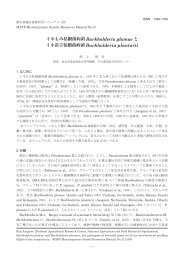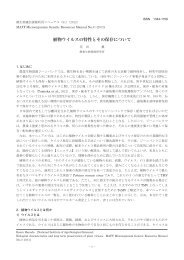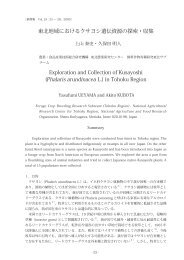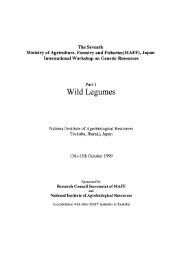Contents - NIAS Genebank
Contents - NIAS Genebank
Contents - NIAS Genebank
- No tags were found...
You also want an ePaper? Increase the reach of your titles
YUMPU automatically turns print PDFs into web optimized ePapers that Google loves.
Study tour to the bean sprout factory, Yukiguni Maitake Co. Ltd. Minamiuonuma, Niigata, JapanOpening RemarksDr. H. HirochikaGlycine Genetic ResourcesDr. D.A. VaughanVigna Genetic ResourcesDr. N. TomookaGlycine GenomicsDr. K. HaradaVigna GenomicsDr. A. KagaVigna TransformationDr. P.K. JaiwalProduction & Breeding(Japan)Dr. M. HajikaProduction & Breeding(India)Dr. M. Pandiyan
Production & Breeding(Thailand)Dr. P. SrinivesProduction & Breeding(Lao PDR)Ms. K. KanyavongProduction & Breeding(Indonesia)Dr. R. SoehendiProduction & Breeding(China)Prof. C. XuzhenProduction & Breeding(China)Ms. T. JingClosing RemarksDr. M. KawaseHokkaido SatelliteSymposium,Opening Remarks,Mr. HanaokaProduction & Breeding(Hokkaido, Japan)Mr. H. ShimadaSoybean FloweringDr. J. AbeAzuki Bean DiseasesDr. N. KondoAzuki Bean NematodeMr. S. Aoyama
Hokkaido Satellite Symposium at Tokachi Agricultural Experiment Station. In front ot the Seed Monument of “Erimo-shozu”,the most popular azuki bean cultivar released from this station.Study tour to the “Sapporo Beer Factory”, Eniwa, Hokkaido, Japan
The 14thNational Institute of Agrobiological Siences, Japan(<strong>NIAS</strong>)International Workshop on Genetic ResourcesGenetic Resources and Comparative Genomicsof Legumes (Glycine and Vigna)September 14, 2009Sponsored byNational Institute of Agrobiological SciencesPublished November 2011ISBN 978-4-931511-22-4
Welcome AddressHirochika HirohikoDirector, Division of Genome and Biodiversity Research, National Institute of Agrobiological SciencesI would like to welcome all participants to this workshop. I am particularly happy to welcome friends andcollaborators who have made long journeys from overseas.Recently in the press there are repeated warnings that global food security is threatened by various factorsincluding global climate changes and increasing population. FAO predicts that Asia will lack the means tofeed the extra 1.5 billion people that will live on our continent by 2050.Of human foods there are two groups that are most important - cereals and legumes. Research progressin understanding the main cereal of Asia, rice, has established this crop as a model for all crops. Legumeshave received less attention than the cereals until recently, but now there are a number of new researchinitiatives to address legume crops.Today this workshop will focus on two major and closely related legume genera - Vigna and Glycine. TheVigna includes many important cultivated legumes including cowpea, mungbean and azuki bean. Vignaare the major legumes of South Asia and Africa. Glycine is the genus of soybean. Soybean is the mostimportant legume globally. In Japan there are abundant genetic resources of both these genera and Japan isa center of diversity for soybean and wild soybean as well as azuki bean and wild azuki bean.The National Institute of Agrobiological Science <strong>Genebank</strong> has taken a leadership role in collecting,conserving and conducting research on genetic resources of Japanese Vigna and Glycine. Through ourcollaborators, many of the overseas participants here today, we have also been collecting and conservingthese genera from other countries. These genetic resources are invaluable resources for breeding andgenomics research.Recently <strong>NIAS</strong> embarked on a soybean genomics project and this is complemented by the pioneeringVigna genomics research also being conducted in <strong>NIAS</strong>. Our soybean genomics initiative is part of a globaleffort to understand the genome of soybean so that more progress can be achieved in soybean breeding.The soybean genome is a distinct challenge because of its size but fortunately developments in sequencingand information management mean that rapid progress is being made and some of that progress will bereported today.The meeting today will provide an opportunity to discuss what is being done and also what needs tobe done in different countries to make progress in conservation, evaluation and use of legume geneticresources and also legume genomics. I hope that by the end of the day you will all have ideas that willbenefit your future work. In addition, for those that are going for the satellite workshop in Hokkaido, I hopetoday ‘breaks the ice’ and enables you to develop new linkages with colleagues in different countries.
Glycine Genetic Resources<strong>Contents</strong>Vaughan D.A., N. Tomooka, A. Kaga, T. Isemura and Y. Kuroda 1Vigna Genetic ResourcesTomooka N., A. Kaga, T. Isemura, Y. Kuroda, D.A. Vaughan, P. Srinives, P. Somta,S. Thadavong, C. Bounphanousay, K. Kanyavong, P. Inthapanya, M. Pandiyan, N. Senthil,N. Ramamoorthi, P.K. Jaiwal, T. Jing, K. Umezawa and T. Yokoyama 11Genetic and Molecular Analysis of Soybean GenomeHarada, K., A. Kaga, Y. Katayose, Y. Tsubokura, S. Sato, S. Watanabe, Z. Xia,M. Hayashi, H. Kanamori, T. Shimizu, K. Machita, H. Ikawa, T. Ito, K. Kurita, K. Ito,J. Wu, T. Matsumoto, S. Tabata and T. Sasaki 23Asian Vigna Genome ResearchKaga A., T. Isemura, T. Shimizu, P. Somta, P. Srinives, S.Tabata, N. Tomookaand D.A. Vaughan 33Genetic Transformation of Vigna Species: Current Status and Future ProspectivesChaudhary D., M. Sainger, L. Sahoo and P.K. Jaiwal 41Present State and Prospect of Soybean Production and Soybean Breeding in JapanHajika M. 49Present Status and Future Perspectives of Glycine and Vigna in IndiaPandiyan M., N. Senthil, N. Ramamoorthi and S.K. Ganesh 53Interspecific Hybridization of Vigna radiata x 13 wild Vigna SpeciesPandiyan M., N. Senthil, N. Ramamoorthi and T. Jayaraj 61Present Status and Future Perspectives of Glycine and Vigna in ThailandSrineves P. and P. Somta 63Status of Glycine and Vigna in the Lao PDRKanyavong K., C. Bounphanousay, P. Inthapanya and B. Kanyavong 69Present Status and Future Perspectives of Soybean Production in IndonesiaSoehendi R. 77
Status and Future Perspectives of Vigna (Mungbean and Azuki bean) Production andResearch in ChinaXuzhen C. and T. Jing 83Azuki Bean Cultivation in Hokkaido and Breeding at Tokachi Agr. Exp. StationShimada H., A.Tazawa, and H.Sato 87Genetic Diversity and Its Use in SoybeanAbe J. 91Brown Stem Rot and Phytophthora Stem Rot: Limiting Factors in Azuki Bean ProductionKondo N. 99Breeding Soybean Cyst Nematode Resistant Azuki Bean using Wild Vigna GermplasmAoyama S. and A. Kushida 103













